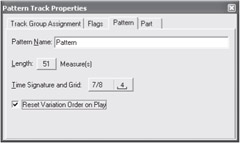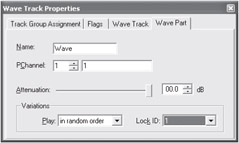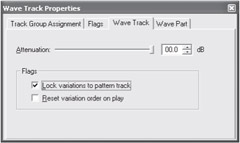Specifying Variation Behavior Settings
Once you have created a Segment that utilizes variations, the next logical step is to be able to more finely control how variations are chosen. For instance, if we had 20 variations of a dialog fragment, we would really like the person hearing this Segment not to hear the same variation played twice in a row. Actually, it would often be ideal to play every possible variation once before we ever get a repeat. This kind of functionality can be specified by the audio producer from each part's properties page.
As usual, right-click a part and choose Properties (or if the Properties page was already open, click the part to make it the active property display).

Figure 3-8: Selecting per-part variation behavior for a Pattern Track part.

Figure 3-9: Selecting per-part variation behavior for a Wave Track part.
Though presented in different locations on the Pattern Track and Wave Track property pages, the available options and functionality are the same:
-
In random order: The default behavior — a new variation is randomly selected from the enabled variations every time the piece of music plays or loops. Repeats can occur.
-
In order from first: The first time the Segment is played, variation 1 (or the first enabled variation) is played. On each repeat or loop, the next enabled variation in order is played.
-
In order from random: The first time the Segment is played, a random enabled variation is chosen. On each repeat or loop, the next enabled variation in order is played.
-
With no repeats: Random enabled variations are chosen on each repeat or loop, but the same variation will not be chosen twice in a row.
-
By shuffling: On each repeat or loop, a random enabled variation is chosen, but every enabled variation will be played once before any are repeated.
Recall that a new variation is chosen each time a Segment is played or it loops. However, there are situations where we might want to "reset" the variations. For instance, let's say that each variation is the next step up in an ascending scale, and we allow the Segment to loop as the character picks up tokens. If they haven't picked up any tokens in the last few minutes, we want to stop the Segment and start the scale over from the lowest note the next time a new token is picked up. This is where the Reset Variation Order on Play option (available in The Wave Track and Pattern Track property pages) can be used to control whether DirectMusic "remembers" which variations were previously played the next time the Segment starts. If, for instance, a Segment was set at In Order from First and its Pattern Track had Reset Variation Order on Play checked, every time the Segment was played, it would start from variation 1. If it looped, it would then play variation 2, 3, and so on.

Figure 3-10: Reset Variation Order on Play functionality for the Pattern Track.
There are, of course, instances where the audio producer would prefer for two or more parts to always pick their variations identically. For instance, in a DirectMusic arrangement of a jazz trio, there might be several "solos" for each of the instruments (parts). We do not want two instruments to "compete" by playing their solos at the same time. For these kinds of situations, Lock ID functionality provides a way to control how different parts choose their variations. Every part that has the same Lock ID will choose its variation to be the same. Therefore, for the above scenario, if each part has three solos to choose from, we could place the drum part's solos on variations 1-3, the guitar's solos on variations 4-6, and the piano's solos on variations 7-9, for example. For the variations where the parts do not have solos, they would either "lay out" or just keep time. When the Segment was played, each of the parts would choose its variations in step with the other parts, so only one solo would be played at a time.

Figure 3-11: This Wave Track part's Lock ID is set to 1. Any other Wave Track parts in the Segment that are set to Lock ID 1 will choose the same variation as this part.
Note that Lock ID does respond to the other settings that we've discussed that control how variations are chosen; if one locked part has variation 10 disabled, that variation will never be chosen for that entire Lock ID group. Similarly, if one part is set to play its variations in order, all of the parts will follow that part's lead. Mixing and matching between various part variation settings (for instance, one part set to shuffle, another part set to play in order) within a Lock ID group can lead to somewhat unpredictable variation choices, so it's generally recommended that all parts in a Lock ID group use the same settings.
Another important concept to remember is that Lock ID is unique per Track, not per Segment. That is, several parts in a Pattern Track that use the same Lock ID will choose the same variation. However, a Pattern Track part and a Wave Track part using the same Lock ID will not lock to each other. A limited subset of this kind of functionality is available in the Wave Track's property page with the Lock Variations to Pattern Track option. Checking this box means that each pchannel of the Wave Track is now locked to the corresponding pchannel of the Pattern Track; a Wave Track part on pchannel 1 will always choose the same variation as the Pattern Track part on pchannel 1 if one is present.

Figure 3-12: Locking a Wave Track's variation to a Pattern Track.
Locking a Wave Track's variations to a Pattern Track is most useful when you wish to use MIDI continuous controllers to manipulate waves — panning, MIDI volume control (fade in, fade out, etc.), and so on. By authoring corresponding variations in the Pattern Track, you can ensure that a particular wave plays using particular MIDI controller information. Alternatively, you could keep the Wave Track unlocked from the Pattern Track, in which case any of your controller variations might be used over any Wave Track variation.
EAN: 2147483647
Pages: 170